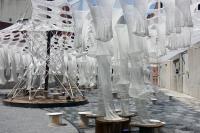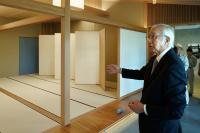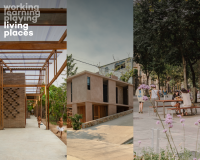OCT Tower
Shenzhen, China
Studio Link-Arc’s proposal for the OCT Tower originated from detailed observation of the site. Defined by an existing office building and bordered by the nearby Hantang tower, an existing sculpture park, and a major vehicular thoroughfare, the design needed to reconcile many different conditions. Early in the design process, SLA decided to avoid typical urban development models which create cramped urban spaces and diminish public landscape, opting instead for a new approach. Studio Link-Arc’s scheme for the OCT Tower seamlessly integrates architecture, landscape, and urbanism, creating a contemporary public space for residents, visitors, and office workers.
SLA’s first design move was to lift the tower from its podium. This gesture allows daylight to reach deep into the commercial spaces and creates more public space at grade. The roof of the podium is then articulated as a public landscape and is extended across the site to connect to the Hantang plaza to the east, create a generous entry plaza, and to create a narrower building depth that promotes natural lighting. This landscaped roof provides a new outdoor garden and sculpture space for visitors, residents, and office workers to enjoy. The office lobby is located atop this landscaped roof, enlivening the park and creating a ceremonial entrance to the tower above.
The addition of gardens on the south façade allows the park to extend from the ground level into the tower, adding amenities for the office workers. These outdoor gardens create cooler shaded spaces in the summer and passively warmed zones in the winter, enhancing user comfort and enhancing the building’s environmental response. In addition, the office tower is punctuated by a series of sky lobbies, creating extensive outdoor areas that allow workers to take breaks and conduct informal meetings.
The depth of the floor plate reduces as the floors rise, allowing natural light to penetrate deeply into the office spaces while allowing for stunning panoramic views. A shaded southern façade improves energy efficiency and increases user comfort by reducing solar heat gain. The top of the building includes a clubhouse, with an interior garden that enjoys panoramic views of the city. A restaurant and lounge on the lower levels of the clubhouse is designed to maximize these views.
- Architects
- Studio Link-Arc
- Location
- Shenzhen, China
- Year
- 2016
- Client
- OCT Group
- Team
- Yichen Lu, Ted Kane, Amy Shu Chang, Paul Schelechow, Zifan Liu, Dongyul Kim, Satoru Sugihara

























